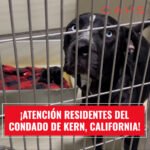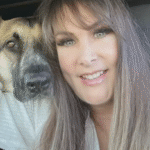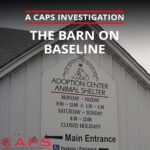Breeder: Hibbard, Larry & Cindy
Business name: Hibbard Farm
Address: RR 1, Box 51
City, State Zip: Toronto, KS 66777
Year: 2004
USDA License: 48-A-1321
USDA Inspector: Karl Thornton, ACI
USDA Inspections: 2003-07-15
Date of CAPS Investigation: 2004-08-27
About 60 dogs and 8 puppies. Breeds: Beagles, Maltese, Poodles, Chihuahuas, Huskies, Dachshunds, Australian Ridgebacks
Two Sundowner kennels
Larry and Cindy Hibbard’s facility consisted of several different kennels, two of which were Sundowner Kennels with indoor and outdoor cages about two feet long, two feet wide, and 18 inches tall connected with doggie-doors. Each kennel had about 24 cages, with two stacked rows of six cages each, on each side. Each cage housed two to three dogs.
The doggie-doors had feces and oil buildup on their surfaces (3.1(c)(2)-Maintenance and replacement of surfaces) (3.11(a)(2)-Cleaning of primary enclosures). The doors of the outside cages were made of untreated wire that was rusting, and the tops of several of the cages had rusting wire (3.1(c)(1)(i)-Surfaces). Wire near the back of a kennel was bent and protruding into the cage (3.1(c)(1)(ii)-Surfaces).
Inside the kennels were lix-it systems for watering the dogs and plastic self feeders attached to the inside cage doors. These feeders were about 10 inches tall and filled to capacity with dog food, a quantity obviously too much for the dogs inside any of the cages to eat in one day (3.9(a)-Feeding).
Roofed kennel
Another facility near the property access road was about 30 feet long and 15 feet wide with a peaked roof and indoor/outdoor cages. The six outdoor cages were each about three feet tall, three feet wide, and three feet long and positioned over concrete flooring. The inside cages were about 30 inches tall, three feet wide, and three feet long. The doggie-doors connecting them had oil and feces buildup (3.11(a)(2)-Cleaning of primary enclosures). Each cage, made of untreated thick-gauge wire, contained two Australian Ridgebacks or Huskies.
Wooden boards were wired to the outside wire walls separating the pens in such a way that wires protruded into the pens (3.1(c)(1)(ii)-Surfaces). These boards had oil and feces residue covering them (3.11(a)(2)-Cleaning of primary enclosures) and were chewed and scratched so that chunks of them were missing (3.1(a)-Structure; construction). Plastic food containers were placed on the outside flooring of the pens (3.9(b)-Feeding).
First outdoor facility
Next to the indoor/outdoor kennel, away from the road, were three pens on concrete flooring, each about five feet wide and ten feet long, with walls about six feet high made of untreated, thick-gauge wire. Each pen housed three Australian Ridgebacks and contained a lix-it style watering system and a large plastic food dish placed on the concrete flooring in a manner that did not minimize contamination by excreta and pests (3.9(b)-Feeding).
Each pen also contained a single, plastic igloo-style dog house. They were not large enough for all three dogs in the pen to fit inside and lie down in a normal manner or turn about freely (3.4(b)-Shelter from the elements. These pens did not have wind breaks on them (3.4(b)(3)-Shelter from the elements).
Next outdoor facility
The facility furthest from the road consisted of about a dozen outdoor pens on concrete flooring. These pens were about five feet wide and twenty feet long and had walls of thick-gauge wire about six feet high. These pens housed Beagles and Huskies
At the back of each pen was a wooden box, which had been created by placing wooden boards over wire. The wooden walls were torn, chewed, and scratched away in several areas (3.1(a)-Structure; construction). Metal sheets placed over the wooden roofing were covered in rust (3.1(c)(1)(i)-Surfaces).
Each of these pens contained metal buckets for water and plastic igloo-style dog houses. These dog houses were not large enough to allow all of the dogs in each pen to be inside at once and lie down in a normal manner or turn about freely (3.4(b)-Shelter from the elements). The dog houses had no wind breaks (3.4(b)(3)-Shelter from the elements).
The wire at the end of these pens, and at several other parts of this kennel, was rusting (3.1(c)(1)(i)-Surfaces). One of the pens housing several Beagles had a large web (3.11(a)-Cleaning of primary enclosures).
Another indoor/outdoor kennel
The facility closest to the property access road was about 20 feet long and 15 feet wide. There were six outdoor cages on each side of the building, which were connected to indoor pens by doggie doors. The outside cages were over concrete flooring and made of wood and treated wire with untreated-wire doors (3.6(a)(2)(xii)-Primary enclosures). The doggie doors had oil and feces build-up on them (3.1(c)(2)-Maintenance and replacement of surfaces) (3.11(a)(2-Cleaning of primary enclosures). Chihuahuas and Dachshunds were running in and out of these cages.
A lix-it watering system was set up for the outside cages. A bleach container sat on top of one of the cages (3.1(e)-Storage). Plastic food dishes were set on the outside cage wire flooring (3.9(b)-Feeding).




